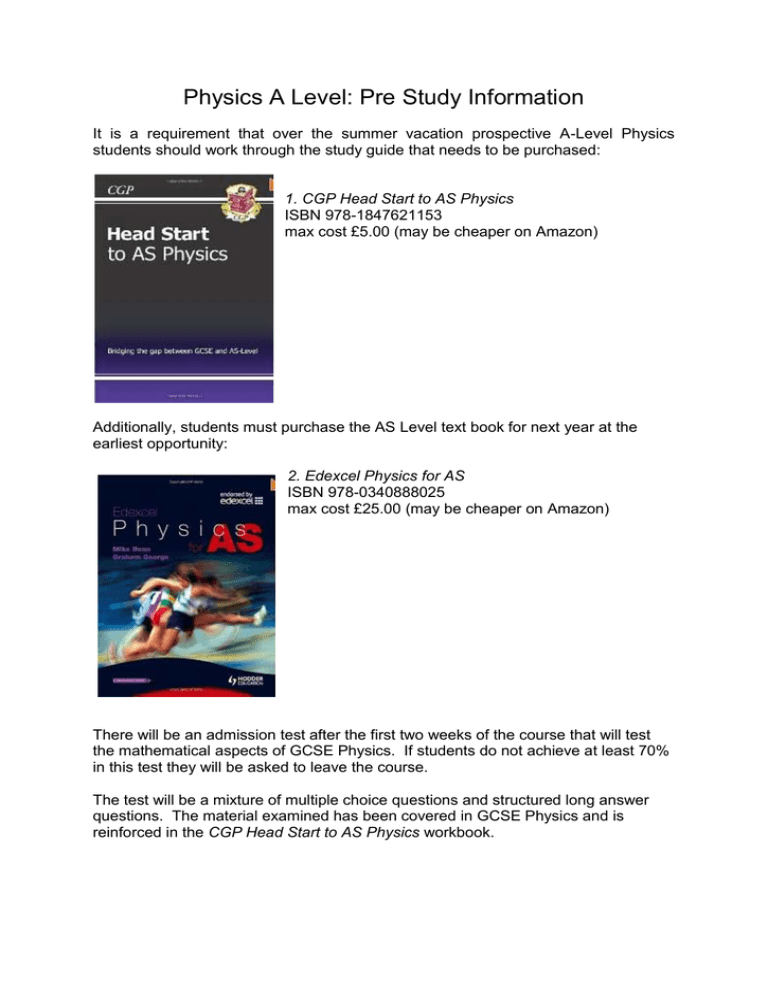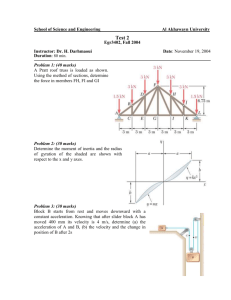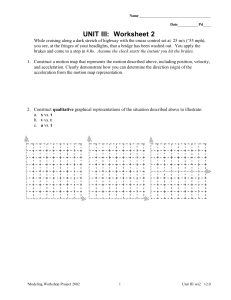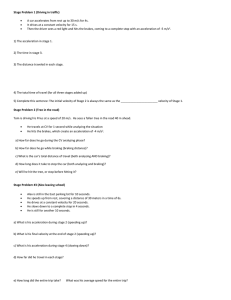Physics A Level.
advertisement

Physics A Level: Pre Study Information It is a requirement that over the summer vacation prospective A-Level Physics students should work through the study guide that needs to be purchased: 1. CGP Head Start to AS Physics ISBN 978-1847621153 max cost £5.00 (may be cheaper on Amazon) Additionally, students must purchase the AS Level text book for next year at the earliest opportunity: 2. Edexcel Physics for AS ISBN 978-0340888025 max cost £25.00 (may be cheaper on Amazon) There will be an admission test after the first two weeks of the course that will test the mathematical aspects of GCSE Physics. If students do not achieve at least 70% in this test they will be asked to leave the course. The test will be a mixture of multiple choice questions and structured long answer questions. The material examined has been covered in GCSE Physics and is reinforced in the CGP Head Start to AS Physics workbook. Physics AS Level: Sample admission test 1. A car pulls a trailer of weight 2500 N with a force of 20 N for a distance of 8 km along a horizontal road. How much work is done by the car in pulling the trailer? A 160 J B 20 000 J C 160 000 J D 20 000 000 J (Total 1 mark) 2. Which of the following is a scalar quantity? A acceleration B displacement C force D work (Total 1 mark) 3. A bus is travelling at a speed of 9.0 m s–1. It then accelerates at a rate of 0.75 m s–2 for a time of 8.0 s. What is its final speed? A 6.0 m s–1 B 15 m s–1 C 17 m s–1 D 21 m s–1 (Total 1 mark) 4. A person weighing 100 N stands on some bathroom scales in a lift. If the scales show a reading of 110 N, which answer could describe the motion of the lift? A Moving downwards and decelerating. B Moving downwards with a constant velocity. C Moving upwards and decelerating. D Moving upwards with a constant velocity. (Total 1 mark) 5. The graph shows how velocity varies with time for an object. The total distance travelled by the object in 4 s is A 20 m B 40 m C 60 m D 80 m (Total 1 mark) 6. There has been a proposal to build a train tunnel underneath the Atlantic Ocean from England to America. The suggestion is that in the future the trip of 5000 km could take as little as one hour. Assume that half the time is spent accelerating uniformly and the other half is spent decelerating uniformly with the same magnitude as the acceleration. (a) Show that the acceleration would be about 2 m s–2. ..................................................................................................................................... ..................................................................................................................................... ..................................................................................................................................... ..................................................................................................................................... ..................................................................................................................................... (2) (b) Calculate the maximum speed. ..................................................................................................................................... ..................................................................................................................................... Speed = .............................................. (2) (c) Calculate the resultant force required to decelerate the train. mass of train = 4.5 × 105 kg ..................................................................................................................................... ..................................................................................................................................... Force = ............................................... (2) (Total 6 marks) 7. The Saturn V rocket used in NASA’s space programme had a mass of 3.04 × 106 kg. It took off vertically with a thrust force of 3.40 × 107 N. (a) Show that the resultant force on the rocket is about 4 × 106 N. ..................................................................................................................................... ..................................................................................................................................... ..................................................................................................................................... (3) (b) Calculate the initial acceleration. ..................................................................................................................................... ..................................................................................................................................... Initial acceleration = ........................................ (2) (c) After 150 s the rocket reached a speed of 2390 m s–1. Calculate its average acceleration. ..................................................................................................................................... ..................................................................................................................................... ..................................................................................................................................... Average acceleration = ..................................... (2) (d) Suggest why the initial acceleration and average acceleration are different. ..................................................................................................................................... ..................................................................................................................................... (1) (Total 8 marks) 8. The diagram shows part of a rollercoaster ride. The car begins its descent at P where it has negligible speed. It reaches maximum speed at Q. P Car and passengers 60 m Q 10 m (a) If there were no forces opposing its motion, show that the speed of the car at Q would be approximately 30 m s–1. ..................................................................................................................................... ..................................................................................................................................... ..................................................................................................................................... ..................................................................................................................................... ..................................................................................................................................... (3) (b) A braking system is used to prevent the car travelling faster than 27 m s–1. (i) The car and passengers shown in the diagram have a total mass of 750 kg. The length of track from P to Q is 80 m. Calculate the average braking force that would be required if the speed of the car is to be limited to 27 m s–1. .......................................................................................................................... .......................................................................................................................... .......................................................................................................................... .......................................................................................................................... .......................................................................................................................... Braking force = ........................................ (3) (ii) In practice, the braking system would not have to produce this magnitude of force. Suggest why. .......................................................................................................................... .......................................................................................................................... (1) (iii) Explain whether the braking force would have to change if the car was carrying a heavier load of passengers. You may be awarded a mark for the clarity of your answer. .......................................................................................................................... .......................................................................................................................... .......................................................................................................................... .......................................................................................................................... .......................................................................................................................... .......................................................................................................................... .......................................................................................................................... .......................................................................................................................... (4) (Total 11 marks)




